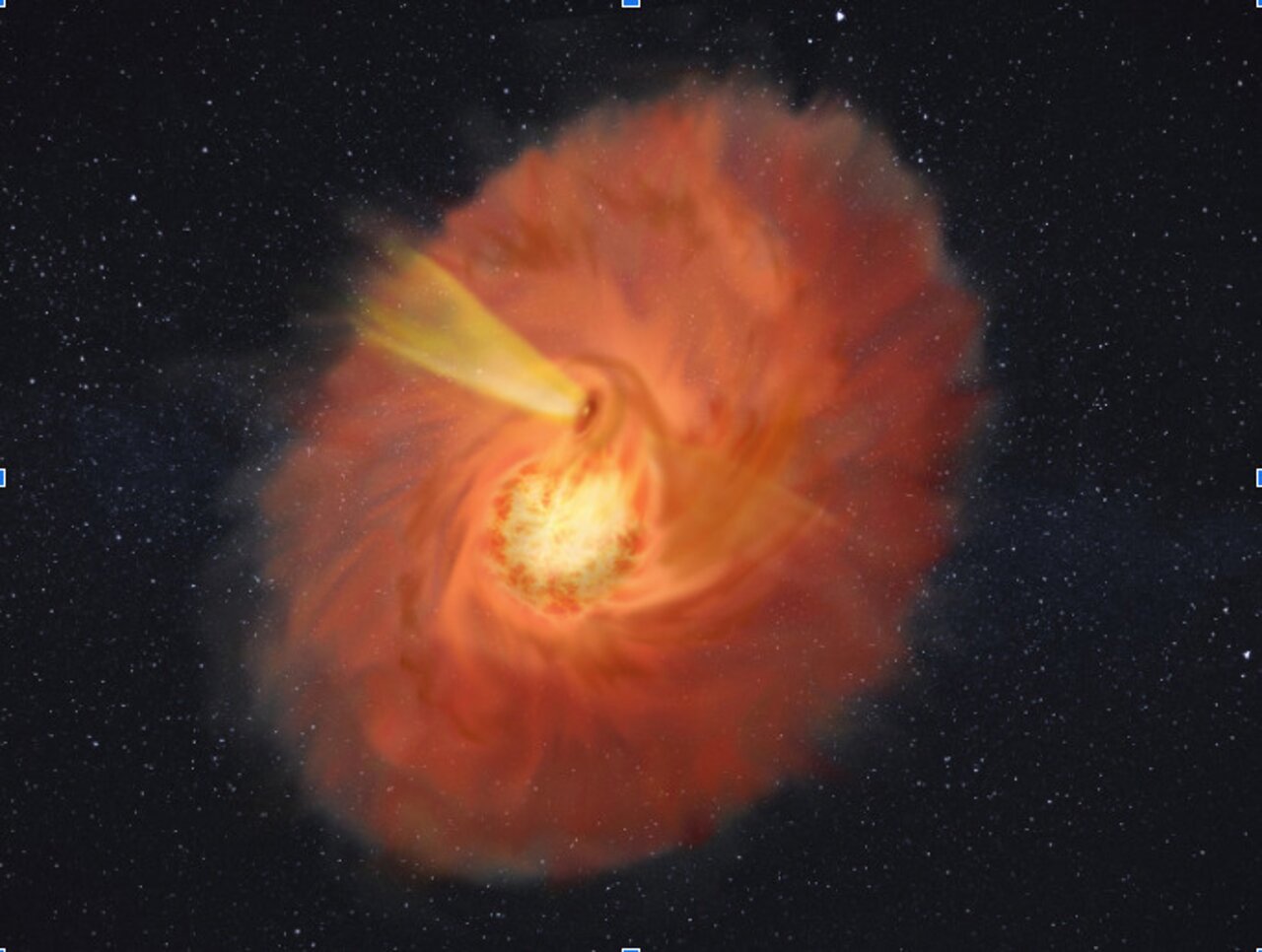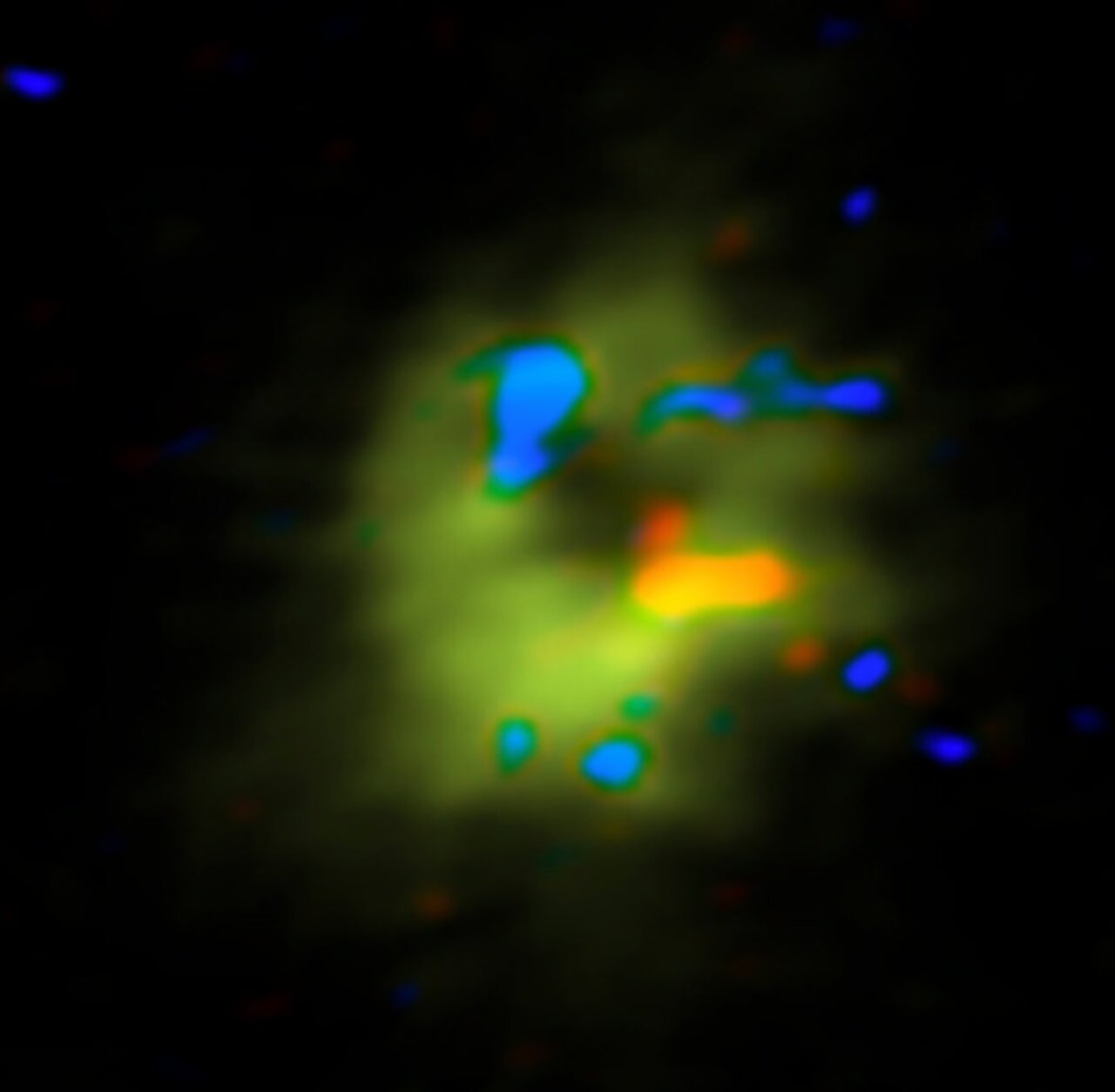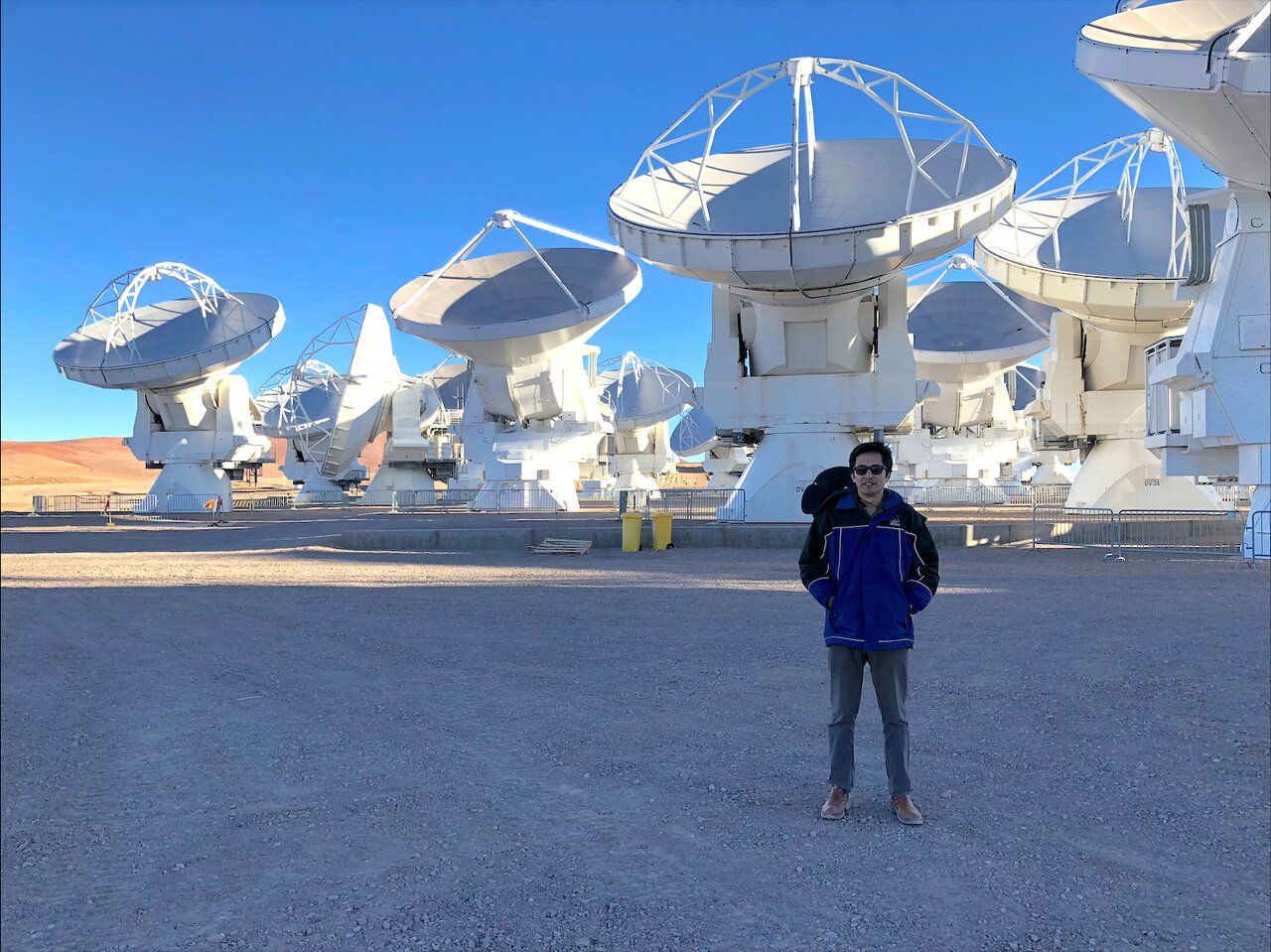- What a born-again star is
- How astronomers discovered these elusive stellar objects
- How ALMA unveiled some of their secrets
How does a star die? Like anything in astronomy, the answer is never simple. Depending on their mass, stars undergo complicated cycles of birth and death and now, scientists think, rebirth. Over the course of the last century, astronomers have discovered that some “born-again” stars experience a short second lease of life. Only a handful of these objects have ever been observed, but a team of astronomers is on the hunt for their true nature. Using the Atacama Large Millimeter/sub-Millimeter Array (ALMA), of which ESO is a partner, they have been able to observe some of the fascinating quirks of these stars for the first time.
In the journal Astronomische Nachrichten in 1919, German astronomer Max Wolf described what he thought was a dying star in the process of an immense explosion. The star, V605 Aquilae, flared to brightness in a burst of activity. But V605 Aquilae had an unusual appearance: it flickered, with the star sometimes shining brightly, and sometimes appearing dimmer, before it finally disappeared from sight in 1923. It was not until the 1980s that astronomers proposed an explanation for V605 Aquilae: it was, they said, undergoing a second life.
Life, death, and rebirth: how does a star evolve?
All stars evolve over time, and their evolution depends on their mass. In stars, atoms undergo a process known as nuclear fusion, in which multiple atoms are forced together to form heavier elements. In the simplest case, four hydrogen atoms fuse into one helium atom, releasing huge amounts of energy. The very hot, very dense cores of stars produce heavier and heavier elements until the star has exhausted its ability to continue this process.
When most stars reach this point, they start to dramatically grow in size, entering a red giant phase. If the Sun were to enter its red giant phase, it would grow so large that it would completely consume Earth. Stars more massive than our Sun then undergo a supernova explosion, the brightest of which can be seen from Earth in the middle of the day. But the evolutionary process is different for smaller stars. In this case, after the red giant phase, the star sheds some of its outer material, creating a planetary nebula: a cloud of gas and dust, rich with all the elements the star has forged. What remains is a small core or white dwarf star, which will continue to shine until exhausted, eventually cooling down into darkness.
But some white dwarfs can have a second chance.
“Born-again stars are basically white dwarf stars that come back to life thanks to a very late helium flash, in which any remaining helium in the star undergoes a nuclear reaction,” says Daniel Tafoya, an astronomer at the Onsala Space Observatory in Sweden who has spent the last several years of his career studying these enigmatic stars.
After their so-called first “death”, born-again stars are left with a thin outer shell of helium and, above it, an even thinner shell of hydrogen. For a born-again event to happen, there must be enough helium to ignite nuclear fusion, which for most white dwarfs is not the case just after death.
As Tafoya explains: “The amount of helium is not enough to continue the nuclear reaction on its own, but the very thin layer of hydrogen above it is still undergoing fusion and slowly pouring into the helium layer below. And at some point after thousands of years of pouring in helium drop by drop, you finally have enough to start the fusion process, and it turns out that the helium ‘flashes’ in an explosive way. And suddenly the star shines again in a dramatic second life.”
A crucial piece of evidence for the existence of born-again stars was provided by amateur astronomer Yukio Sakurai in 1995. He found a bright ‘new’ star in the constellation of Sagittarius, and reported his findings[1] to the Circulars of the International Astronomical Union, a global information service for astronomy. Unlike Max Wolf in 1919, by now astronomers had the capacity to really investigate these unusual stars with sophisticated telescopes, and a small team of scientists at ESO’s La Silla Observatory made the first measurements of what came to be known as Sakurai’s Object using the ESO 3.6-metre telescope. And they were stunned by what they found.
Sakurai’s Object behaved in exactly the same way as V605 Aquilae: its brightness, the colours of light it emitted, even its strange flickering. It had all the characteristics of being a star that had already experienced the end of its life. Now, the astronomers knew what to look for, and they turned their telescopes towards Sakurai’s Object in search of a planetary nebula.
And sure enough, there it was: Sakurai’s Object was already surrounded by heavy elements such as carbon and silicon; clear evidence that the star had already undergone its first cycle of life and death. The discovery proved immensely exciting for the astronomy community and only a handful of born-again events have been observed since.
“There’s no one single evolutionary track for stars,” Tafoya says. “And these stars have such a short second life – of only tens of years – which is really very fast in astronomical terms, quicker than the blink of an eye. They allow us to probe stellar evolution on human timescales, when usually these processes take tens of thousands of years.”
Scientists like Tafoya think that born-again stars might be the predecessor to a type of hydrogen-deficient stars that are the ending point of a significant proportion of stars in the universe. As many as a quarter of white dwarf stars are thought to undergo a born-again event. His team also believes that born-again stars undergo a series of dips and peaks in their brightness, like someone gradually turning a dimmer switch up and down.
“V605 Aquilae and Sakurai's object were caught passing through the first bright peak in their born-again event,” says Ramlal Unnikrishnan, part of the team investigating born-again stars. “It could be possible that the other born-again stars we’ve observed are actually already in their second or third peak.”
Spooky stellar shapes
There are many unsolved questions surrounding born-again stars, and Tafoya and his colleagues are on the path to answering some of them. The team has now made the first ever measurements of the shape of the dense clouds of molecular gas and dust in the immediate surroundings of a born-again star. Using ALMA the team found a flat, rapidly expanding disc of gas and dust around V605 Aquilae. More surprising still, they found evidence of high-speed jets of molecules being emitted from opposite directions away from the disc.
“Nobody had ever seen before how the recently-formed molecular gas is distributed in the vicinity of these objects,” says Jesús Toalá, a member of the team researching born-again stars.
“You would probably expect an explosion to look like a shell, right? Exploding in a uniform way across the whole surface of the star,” Toalá continues, “But that’s not what we saw. We saw an explosion like a disc, mostly around the equator of the star, with two clear jets from the poles, close to the central star. When we first saw the jets, that was when we first got goosebumps. We thought, this is really something unexpected.”

Artist´s impression of the potential binary system thought to lie at the heart of V605 Aquilae. During its born-again phase, one star explodes, engulfing its partner. This interaction results in a quickly expanding, relatively flat disc, and the emission of two rapid molecular jets.
Credit: D. Tafoya

ALMA observations of the molecular gas disc around V605 Aquilae. The blue and red structures at its centre are the two jets moving towards us (blue) and away from us (red), while the yellow-green indicates the rapidly expanding disc..
Credit: ESO
|
And what causes these unusual jets? One explanation that the team has is that some born-again systems are not one star, but rather are a pair of stars or binary system. In this case, the dead white dwarf star undergoes a helium flash, suddenly expanding and swallowing its binary partner. Its companion star drags gas around as it orbits the born-again star, causing the formation of a flat, rapidly expanding disc. This also causes the engulfed star to emit the very strong, molecular jets that astronomers can detect.
“The binary system idea is the best explanation we currently have,” continues Toalá, “and the way that science progresses is that people will comment on, confirm, or clarify this theory with additional calculations and measurements.”

Molecular madness
It is not just the shape of these clouds that is perplexing the astronomical community, but also the molecules which are found within them are also unusual. Back in 2017, Tafoya had used ESO’s Atacama Pathfinder Experiment (APEX) to study the molecular composition of both V605 Aquilae and Sakurai’s object.
“The thing about Sakurai’s Object was that people knew that the star became very dark immediately after the late explosion,” Tafoya says. “This means a lot of material is forming around it, gas and dust. And usually when you look closely you can detect some of these molecules, for example, carbon monoxide. But what was so peculiar was that in all the research, people were pointing their telescopes at these stars and seeing… nothing.”
Tafoya had to take a brute force method to find out what molecules surrounded Sakurai’s Object and V605 Aquilae, performing long, involved measurements with ESO’s APEX and hoping to detect the tiniest molecular signals. He adds, “I was sitting in front of my computer processing the data, and then suddenly wham there it was. I remember bursting into my colleague’s office and holding up a graph like ‘There is molecular emission!”’
But even what he detected was strange. Tafoya found that, for his measurements to be correct, the gas would have to be expanding at 1000 kilometres per second, an absolutely incredible speed. He knew this couldn’t be right.
“My team suggested that I was searching for the wrong molecule. With Sakurai’s object, we were looking for carbon monoxide, one of the most easily detectable, abundant elements in this type of planetary nebula,” he tells me. “But my colleagues said, ‘what if it’s some other molecule entirely, like hydrogen cyanide?’ And this gave much more sensible numbers. And then we found with V605 Aquilae, on the other hand, there was carbon monoxide but no hydrogen cyanide.”
The reason for such variation between the two stars remains unclear. One explanation suggests that the difference arises because Sakurai’s Object is much earlier on in its born-again phase than V605 Aquilae. Perhaps V605 Aquilae was also originally rich in hydrogen cyanide, which then got destroyed over time by the star’s radiation.
“To tell the truth, we don’t know the ‘why’ for certain. It might be the case that these were just two stars that had very different chemistry,” says Unnikrishnan. “Part of the problem is that we only have measurements on two born-again stars.”
One thing that is clear is that the team’s results will become the starting point for scientists to make predictions on both born-again pulses and the phenomenon of helium flashes. They hope to dive deeper into explaining these phenomena, but also recognise that born-again stars have the potential to strike a chord with many people.
“As humans, we have an emotional side.” Tafoya concludes, “That tends to make us feel philosophical about stars being reborn — it’s a romantic way of identifying ourselves with the stars. It’s hard not to think of them as really alive.”
Note:
[1] Sakurai’s object was initially believed to be a nova. Novae occur in binary systems composed of a white dwarf and a companion star in close proximity. The white dwarf steals material from the companion and gets enshrouded in a dense atmosphere composed mostly of hydrogen. This gas is heated by the white dwarf until it reaches a critical point that leads to sudden nuclear fusion.
Biography Anita Chandran
Anita Chandran is a science journalism intern at ESO. She recently completed her PhD in laser physics at Imperial College London, where she also worked with the science communication department on the ethics of artificial intelligence. She is a writer and editor, having co-founding Tamarind, a literary magazine focusing on the intersections between the arts and sciences.





